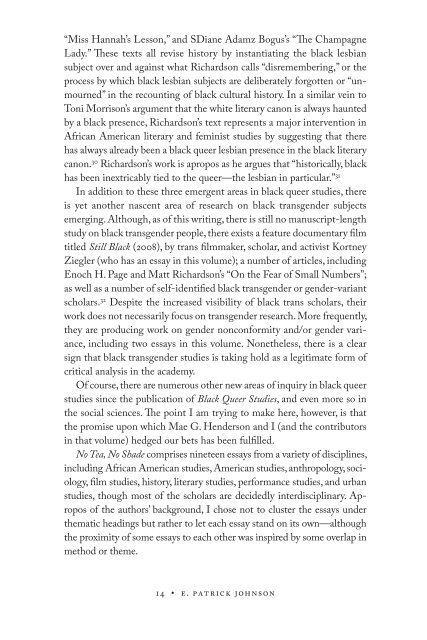No Tea
89AS6wvrf
89AS6wvrf
Create successful ePaper yourself
Turn your PDF publications into a flip-book with our unique Google optimized e-Paper software.
“Miss Hannah’s Lesson,” and SDiane Adamz Bogus’s “The Champagne<br />
Lady.” These texts all revise history by instantiating the black lesbian<br />
subject over and against what Richardson calls “disremembering,” or the<br />
pro cess by which black lesbian subjects are deliberately forgotten or “unmourned”<br />
in the recounting of black cultural history. In a similar vein to<br />
Toni Morrison’s argument that the white literary canon is always haunted<br />
by a black presence, Richardson’s text represents a major intervention in<br />
African American literary and feminist studies by suggesting that there<br />
has always already been a black queer lesbian presence in the black literary<br />
canon. 30 Richardson’s work is apropos as he argues that “historically, black<br />
has been inextricably tied to the queer— the lesbian in par tic u lar.” 31<br />
In addition to these three emergent areas in black queer studies, there<br />
is yet another nascent area of research on black transgender subjects<br />
emerging. Although, as of this writing, there is still no manuscript- length<br />
study on black transgender people, there exists a feature documentary film<br />
titled Still Black (2008), by trans filmmaker, scholar, and activist Kortney<br />
Ziegler (who has an essay in this volume); a number of articles, including<br />
Enoch H. Page and Matt Richardson’s “On the Fear of Small Numbers”;<br />
as well as a number of self- identified black transgender or gender- variant<br />
scholars. 32 Despite the increased visibility of black trans scholars, their<br />
work does not necessarily focus on transgender research. More frequently,<br />
they are producing work on gender nonconformity and/or gender variance,<br />
including two essays in this volume. <strong>No</strong>netheless, there is a clear<br />
sign that black transgender studies is taking hold as a legitimate form of<br />
critical analy sis in the acad emy.<br />
Of course, there are numerous other new areas of inquiry in black queer<br />
studies since the publication of Black Queer Studies, and even more so in<br />
the social sciences. The point I am trying to make here, however, is that<br />
the promise upon which Mae G. Henderson and I (and the contributors<br />
in that volume) hedged our bets has been fulfilled.<br />
<strong>No</strong> <strong>Tea</strong>, <strong>No</strong> Shade comprises nineteen essays from a variety of disciplines,<br />
including African American studies, American studies, anthropology, sociology,<br />
film studies, history, literary studies, per for mance studies, and urban<br />
studies, though most of the scholars are decidedly interdisciplinary. Apropos<br />
of the authors’ background, I chose not to cluster the essays under<br />
thematic headings but rather to let each essay stand on its own— although<br />
the proximity of some essays to each other was inspired by some overlap in<br />
method or theme.<br />
14 • E. Patrick Johnson


